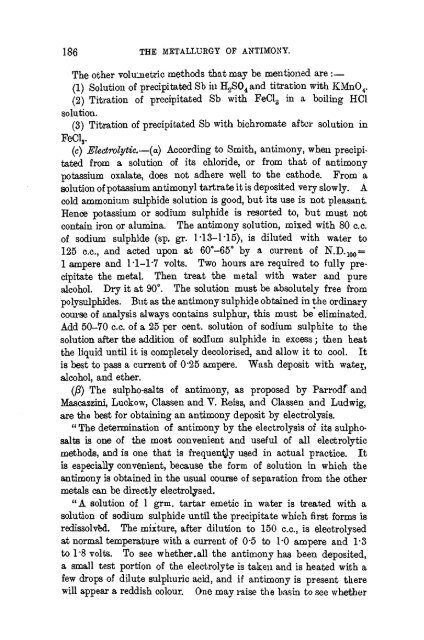antimony - Sciencemadness.org
antimony - Sciencemadness.org
antimony - Sciencemadness.org
Create successful ePaper yourself
Turn your PDF publications into a flip-book with our unique Google optimized e-Paper software.
186 THE METALLURGY OF ANTIMONY.<br />
The other volumetric methods that may be mentioned are :—<br />
(1) Solution of precipitated Sb in H2S04and titration with KMnO4.<br />
(2) Titration of precipitated Sb with FeCl8 in a boiling HC1<br />
solution.<br />
(3) Titration of precipitated Sb with bichromate after solution in<br />
FeCl3.<br />
(c) Electrolytic,—(a) According to Smith, <strong>antimony</strong>, when precipitated<br />
from a solution of its chloride, or from that of <strong>antimony</strong><br />
potassium oxalate, does not adhere well to the cathode. From a<br />
solution of potassium <strong>antimony</strong>l tartrate it is deposited very slowly. A<br />
cold ammonium sulphide solution is good, but its use is not pleasant.<br />
Hence potassium or sodium sulphide is resorted to, but must not<br />
contain iron or alumina. The <strong>antimony</strong> solution, mixed with 80 c.c.<br />
of sodium sulphide (sp. gr. 1*13-1*15), is diluted with water to<br />
125 c.c, and acted upon at 60°-65° by a current of N.D.100 =<br />
1 ampere and 1-1-1*7 volts. Two hours are required to fully precipitate<br />
the metal. Then treat the metal with water and pure<br />
alcohol. Dry it at 90°. The solution must be absolutely free from<br />
polysulphides. But as the <strong>antimony</strong> sulphide obtained in the ordinary<br />
course of analysis always contains sulphur, this must be eliminated.<br />
Add 50-70 c.c. of a 25 per cent, solution of sodium sulphite to the<br />
solution after the addition of sodium sulphide in excess; then heat<br />
the liquid until it is completely decolorised, and allow it to cool. It<br />
is best to pass a current of 0*25 ampere. Wash deposit with water,<br />
alcohol, and ether.<br />
(/3) The sulpho-salts of <strong>antimony</strong>, as proposed by Parrodf and<br />
Mascazzini, Luckow, Classen and Y. Reiss, and Classen and Ludwig,<br />
are the best for obtaining an <strong>antimony</strong> deposit by electrolysis.<br />
" The determination of <strong>antimony</strong> by the electrolysis of its sulphosalts<br />
is one of the most convenient and useful of all electrolytic<br />
methods, and is one that is frequency used in actual practice. It<br />
is especially convenient, because the form of solution in which the<br />
<strong>antimony</strong> is obtained in the usual course of separation from the other<br />
metals can be directly electrolysed.<br />
"A solution of 1 grin, tartar emetic in water is treated with a<br />
solution of sodium sulphide until the precipitate which first forms is<br />
redissolved. The mixture, after dilution to 150 c.c, is electrolysed<br />
at normal temperature with a current of 05 to 1*0 ampere and 1*3<br />
to 1*8 volts. To see whether.all the <strong>antimony</strong> has been deposited,<br />
a small test portion of the electrolyte is taken and is heated with a<br />
few drops of dilute sulphuric acid, and if <strong>antimony</strong> is present there<br />
will appear a reddish colour. One may raise the basin to see whether
















